Enterprise Systems Essay: Advantages, Role, and Architecture Analysis
VerifiedAdded on 2022/09/09
|17
|3595
|17
Essay
AI Summary
This essay critically examines enterprise systems, focusing on their principal advantages such as improved supply chain management, efficient data storage, customer service automation, data security, increased reliability, real-time access to information, standardized processes, improved performance, and better decision-making. It also discusses the role of ERP systems in system integration, highlighting their benefits like supporting production, improving manufacturing flexibility, and ensuring cost control. Furthermore, the essay delves into ERP systems architecture, comparing three-tier, web services, and service-oriented architectures, analyzing their strengths and weaknesses. The document provides an overview of how enterprise systems streamline business operations, improve efficiency, and support strategic decision-making within organizations. The essay also acknowledges the disadvantages of enterprise systems such as high implementation and maintenance costs, and the need for skilled workforce.

Running head: ENTERPRISE SYSTEMS
Enterprise Systems
Name of the Student
Name of the University
Author Note
Enterprise Systems
Name of the Student
Name of the University
Author Note
Paraphrase This Document
Need a fresh take? Get an instant paraphrase of this document with our AI Paraphraser
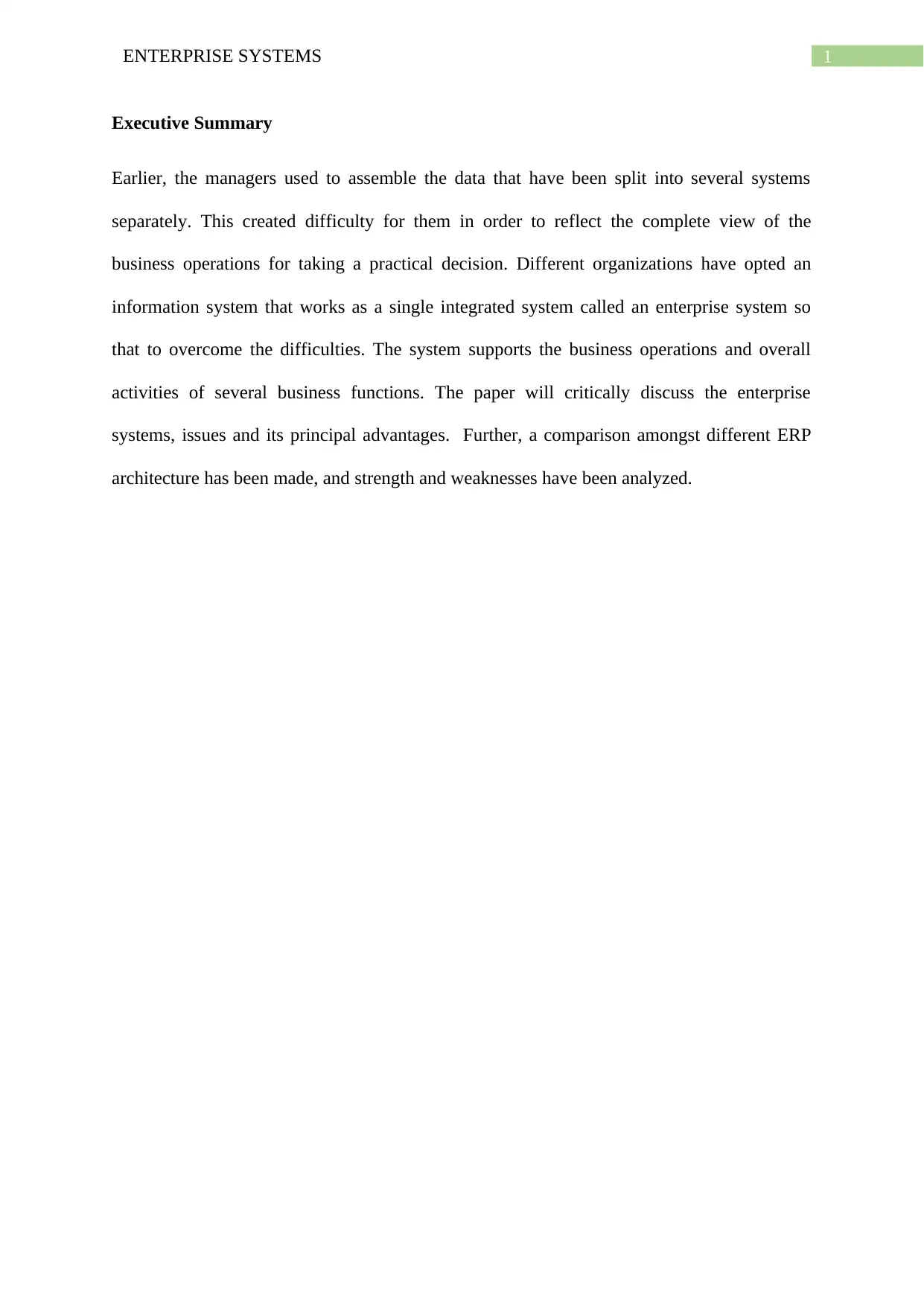
1ENTERPRISE SYSTEMS
Executive Summary
Earlier, the managers used to assemble the data that have been split into several systems
separately. This created difficulty for them in order to reflect the complete view of the
business operations for taking a practical decision. Different organizations have opted an
information system that works as a single integrated system called an enterprise system so
that to overcome the difficulties. The system supports the business operations and overall
activities of several business functions. The paper will critically discuss the enterprise
systems, issues and its principal advantages. Further, a comparison amongst different ERP
architecture has been made, and strength and weaknesses have been analyzed.
Executive Summary
Earlier, the managers used to assemble the data that have been split into several systems
separately. This created difficulty for them in order to reflect the complete view of the
business operations for taking a practical decision. Different organizations have opted an
information system that works as a single integrated system called an enterprise system so
that to overcome the difficulties. The system supports the business operations and overall
activities of several business functions. The paper will critically discuss the enterprise
systems, issues and its principal advantages. Further, a comparison amongst different ERP
architecture has been made, and strength and weaknesses have been analyzed.
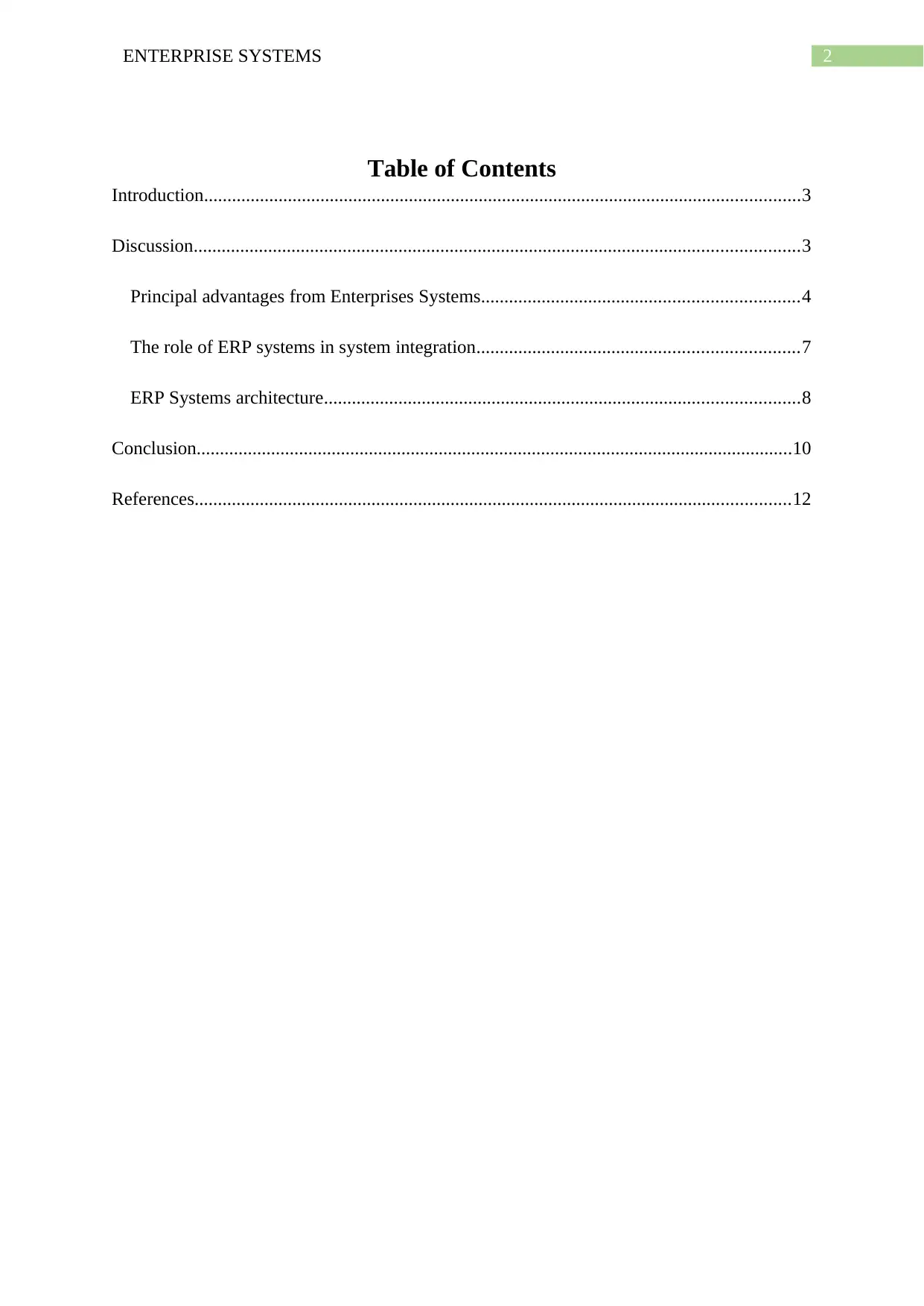
2ENTERPRISE SYSTEMS
Table of Contents
Introduction................................................................................................................................3
Discussion..................................................................................................................................3
Principal advantages from Enterprises Systems....................................................................4
The role of ERP systems in system integration.....................................................................7
ERP Systems architecture......................................................................................................8
Conclusion................................................................................................................................10
References................................................................................................................................12
Table of Contents
Introduction................................................................................................................................3
Discussion..................................................................................................................................3
Principal advantages from Enterprises Systems....................................................................4
The role of ERP systems in system integration.....................................................................7
ERP Systems architecture......................................................................................................8
Conclusion................................................................................................................................10
References................................................................................................................................12
⊘ This is a preview!⊘
Do you want full access?
Subscribe today to unlock all pages.

Trusted by 1+ million students worldwide
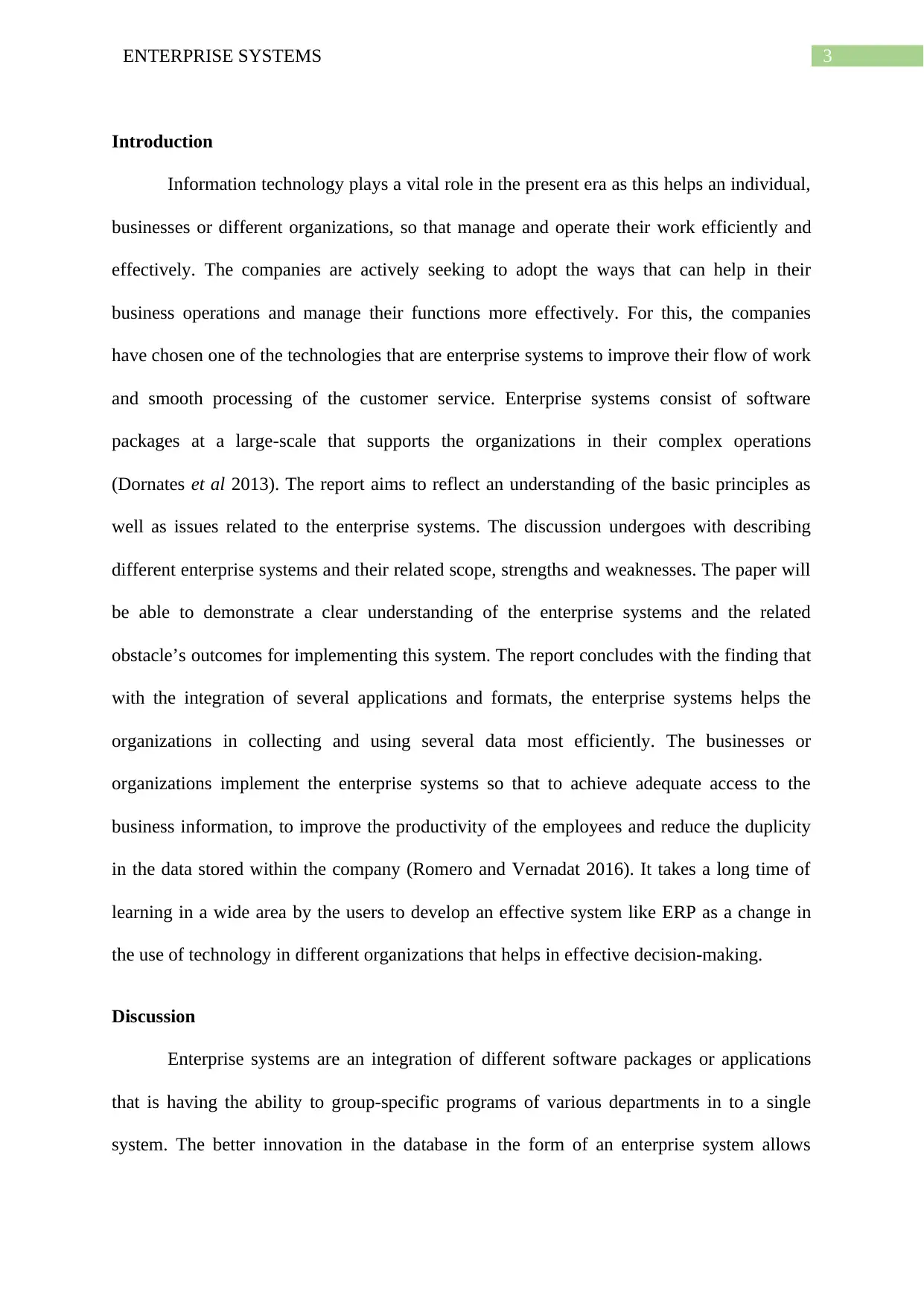
3ENTERPRISE SYSTEMS
Introduction
Information technology plays a vital role in the present era as this helps an individual,
businesses or different organizations, so that manage and operate their work efficiently and
effectively. The companies are actively seeking to adopt the ways that can help in their
business operations and manage their functions more effectively. For this, the companies
have chosen one of the technologies that are enterprise systems to improve their flow of work
and smooth processing of the customer service. Enterprise systems consist of software
packages at a large-scale that supports the organizations in their complex operations
(Dornates et al 2013). The report aims to reflect an understanding of the basic principles as
well as issues related to the enterprise systems. The discussion undergoes with describing
different enterprise systems and their related scope, strengths and weaknesses. The paper will
be able to demonstrate a clear understanding of the enterprise systems and the related
obstacle’s outcomes for implementing this system. The report concludes with the finding that
with the integration of several applications and formats, the enterprise systems helps the
organizations in collecting and using several data most efficiently. The businesses or
organizations implement the enterprise systems so that to achieve adequate access to the
business information, to improve the productivity of the employees and reduce the duplicity
in the data stored within the company (Romero and Vernadat 2016). It takes a long time of
learning in a wide area by the users to develop an effective system like ERP as a change in
the use of technology in different organizations that helps in effective decision-making.
Discussion
Enterprise systems are an integration of different software packages or applications
that is having the ability to group-specific programs of various departments in to a single
system. The better innovation in the database in the form of an enterprise system allows
Introduction
Information technology plays a vital role in the present era as this helps an individual,
businesses or different organizations, so that manage and operate their work efficiently and
effectively. The companies are actively seeking to adopt the ways that can help in their
business operations and manage their functions more effectively. For this, the companies
have chosen one of the technologies that are enterprise systems to improve their flow of work
and smooth processing of the customer service. Enterprise systems consist of software
packages at a large-scale that supports the organizations in their complex operations
(Dornates et al 2013). The report aims to reflect an understanding of the basic principles as
well as issues related to the enterprise systems. The discussion undergoes with describing
different enterprise systems and their related scope, strengths and weaknesses. The paper will
be able to demonstrate a clear understanding of the enterprise systems and the related
obstacle’s outcomes for implementing this system. The report concludes with the finding that
with the integration of several applications and formats, the enterprise systems helps the
organizations in collecting and using several data most efficiently. The businesses or
organizations implement the enterprise systems so that to achieve adequate access to the
business information, to improve the productivity of the employees and reduce the duplicity
in the data stored within the company (Romero and Vernadat 2016). It takes a long time of
learning in a wide area by the users to develop an effective system like ERP as a change in
the use of technology in different organizations that helps in effective decision-making.
Discussion
Enterprise systems are an integration of different software packages or applications
that is having the ability to group-specific programs of various departments in to a single
system. The better innovation in the database in the form of an enterprise system allows
Paraphrase This Document
Need a fresh take? Get an instant paraphrase of this document with our AI Paraphraser
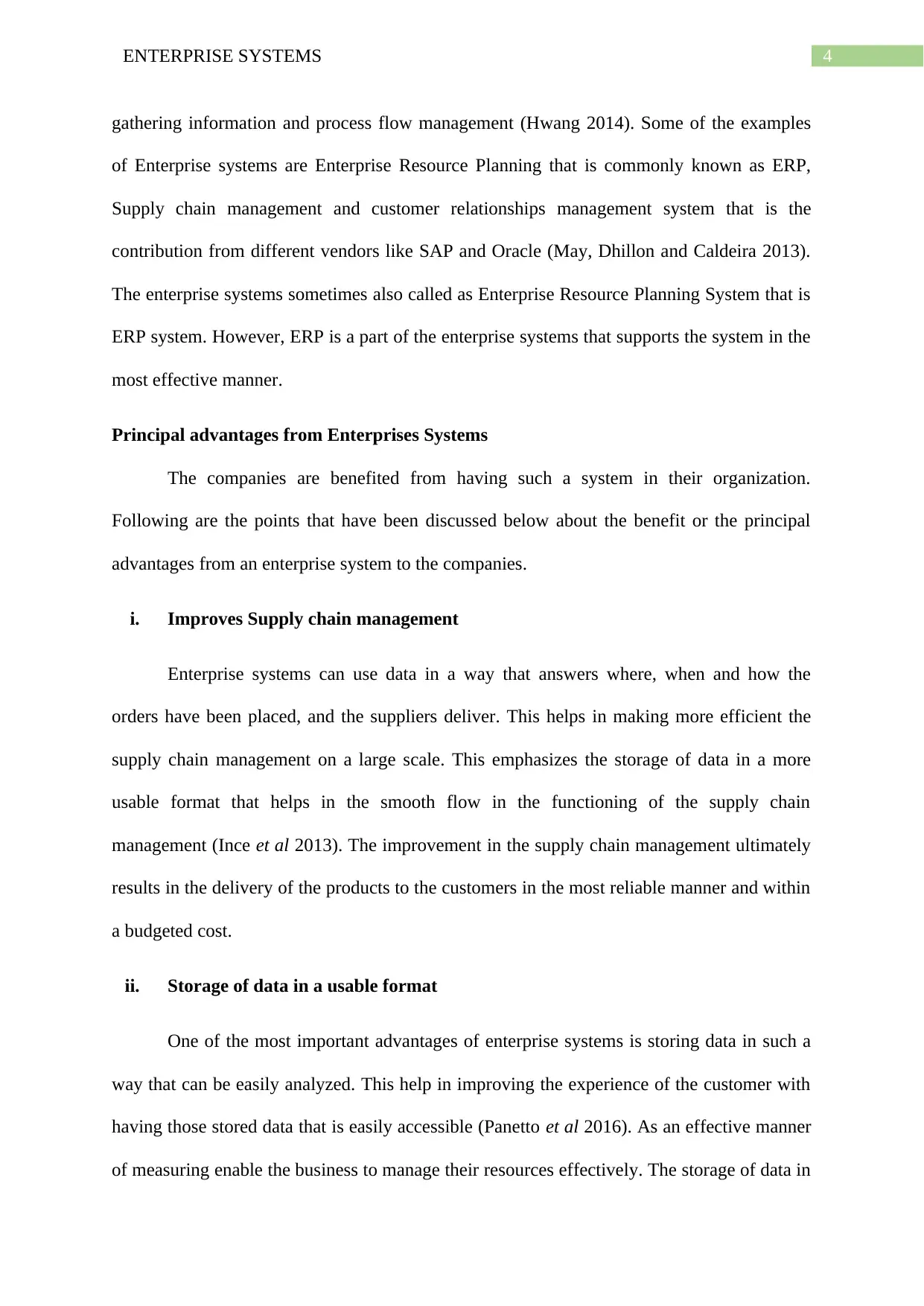
4ENTERPRISE SYSTEMS
gathering information and process flow management (Hwang 2014). Some of the examples
of Enterprise systems are Enterprise Resource Planning that is commonly known as ERP,
Supply chain management and customer relationships management system that is the
contribution from different vendors like SAP and Oracle (May, Dhillon and Caldeira 2013).
The enterprise systems sometimes also called as Enterprise Resource Planning System that is
ERP system. However, ERP is a part of the enterprise systems that supports the system in the
most effective manner.
Principal advantages from Enterprises Systems
The companies are benefited from having such a system in their organization.
Following are the points that have been discussed below about the benefit or the principal
advantages from an enterprise system to the companies.
i. Improves Supply chain management
Enterprise systems can use data in a way that answers where, when and how the
orders have been placed, and the suppliers deliver. This helps in making more efficient the
supply chain management on a large scale. This emphasizes the storage of data in a more
usable format that helps in the smooth flow in the functioning of the supply chain
management (Ince et al 2013). The improvement in the supply chain management ultimately
results in the delivery of the products to the customers in the most reliable manner and within
a budgeted cost.
ii. Storage of data in a usable format
One of the most important advantages of enterprise systems is storing data in such a
way that can be easily analyzed. This help in improving the experience of the customer with
having those stored data that is easily accessible (Panetto et al 2016). As an effective manner
of measuring enable the business to manage their resources effectively. The storage of data in
gathering information and process flow management (Hwang 2014). Some of the examples
of Enterprise systems are Enterprise Resource Planning that is commonly known as ERP,
Supply chain management and customer relationships management system that is the
contribution from different vendors like SAP and Oracle (May, Dhillon and Caldeira 2013).
The enterprise systems sometimes also called as Enterprise Resource Planning System that is
ERP system. However, ERP is a part of the enterprise systems that supports the system in the
most effective manner.
Principal advantages from Enterprises Systems
The companies are benefited from having such a system in their organization.
Following are the points that have been discussed below about the benefit or the principal
advantages from an enterprise system to the companies.
i. Improves Supply chain management
Enterprise systems can use data in a way that answers where, when and how the
orders have been placed, and the suppliers deliver. This helps in making more efficient the
supply chain management on a large scale. This emphasizes the storage of data in a more
usable format that helps in the smooth flow in the functioning of the supply chain
management (Ince et al 2013). The improvement in the supply chain management ultimately
results in the delivery of the products to the customers in the most reliable manner and within
a budgeted cost.
ii. Storage of data in a usable format
One of the most important advantages of enterprise systems is storing data in such a
way that can be easily analyzed. This help in improving the experience of the customer with
having those stored data that is easily accessible (Panetto et al 2016). As an effective manner
of measuring enable the business to manage their resources effectively. The storage of data in
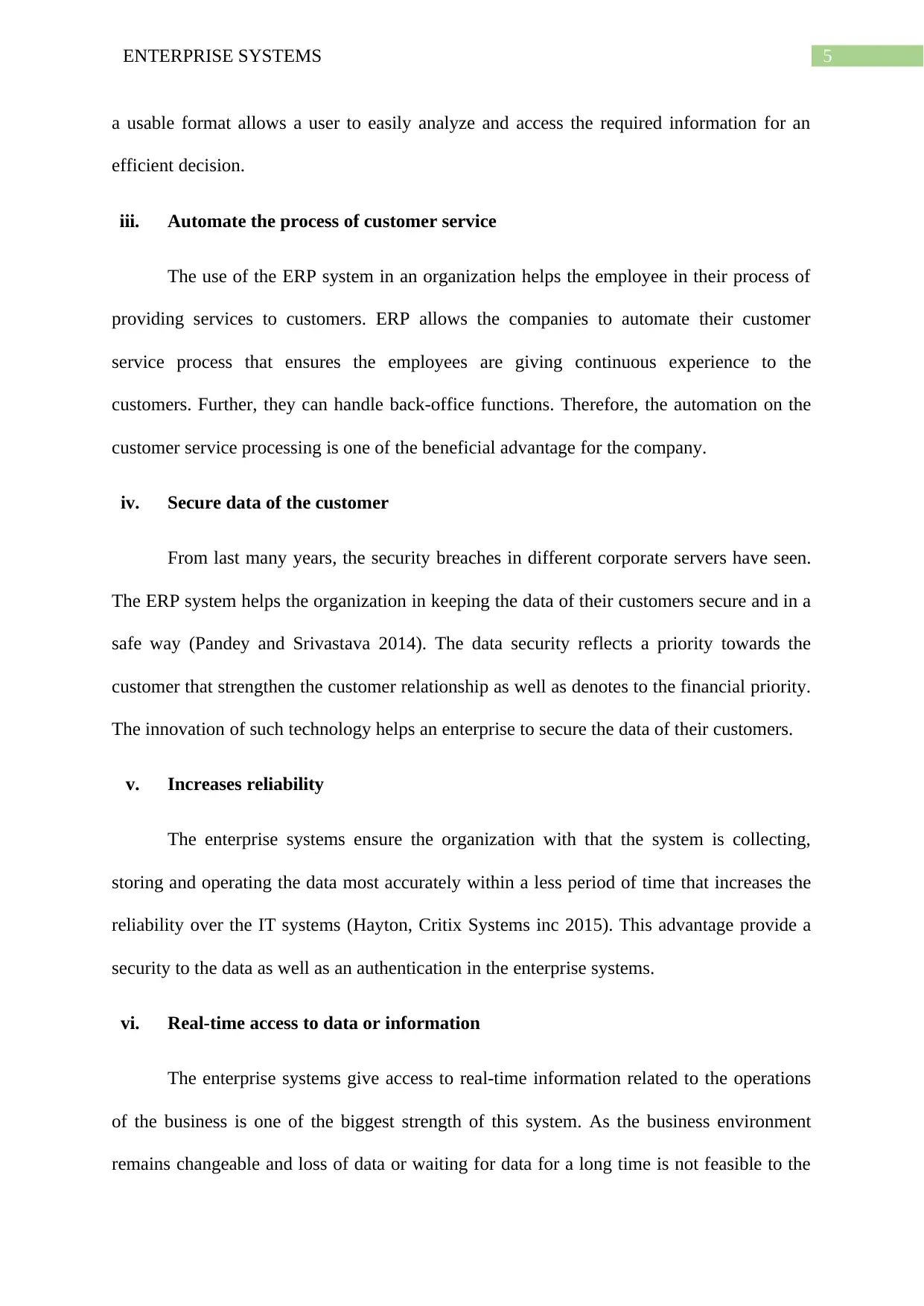
5ENTERPRISE SYSTEMS
a usable format allows a user to easily analyze and access the required information for an
efficient decision.
iii. Automate the process of customer service
The use of the ERP system in an organization helps the employee in their process of
providing services to customers. ERP allows the companies to automate their customer
service process that ensures the employees are giving continuous experience to the
customers. Further, they can handle back-office functions. Therefore, the automation on the
customer service processing is one of the beneficial advantage for the company.
iv. Secure data of the customer
From last many years, the security breaches in different corporate servers have seen.
The ERP system helps the organization in keeping the data of their customers secure and in a
safe way (Pandey and Srivastava 2014). The data security reflects a priority towards the
customer that strengthen the customer relationship as well as denotes to the financial priority.
The innovation of such technology helps an enterprise to secure the data of their customers.
v. Increases reliability
The enterprise systems ensure the organization with that the system is collecting,
storing and operating the data most accurately within a less period of time that increases the
reliability over the IT systems (Hayton, Critix Systems inc 2015). This advantage provide a
security to the data as well as an authentication in the enterprise systems.
vi. Real-time access to data or information
The enterprise systems give access to real-time information related to the operations
of the business is one of the biggest strength of this system. As the business environment
remains changeable and loss of data or waiting for data for a long time is not feasible to the
a usable format allows a user to easily analyze and access the required information for an
efficient decision.
iii. Automate the process of customer service
The use of the ERP system in an organization helps the employee in their process of
providing services to customers. ERP allows the companies to automate their customer
service process that ensures the employees are giving continuous experience to the
customers. Further, they can handle back-office functions. Therefore, the automation on the
customer service processing is one of the beneficial advantage for the company.
iv. Secure data of the customer
From last many years, the security breaches in different corporate servers have seen.
The ERP system helps the organization in keeping the data of their customers secure and in a
safe way (Pandey and Srivastava 2014). The data security reflects a priority towards the
customer that strengthen the customer relationship as well as denotes to the financial priority.
The innovation of such technology helps an enterprise to secure the data of their customers.
v. Increases reliability
The enterprise systems ensure the organization with that the system is collecting,
storing and operating the data most accurately within a less period of time that increases the
reliability over the IT systems (Hayton, Critix Systems inc 2015). This advantage provide a
security to the data as well as an authentication in the enterprise systems.
vi. Real-time access to data or information
The enterprise systems give access to real-time information related to the operations
of the business is one of the biggest strength of this system. As the business environment
remains changeable and loss of data or waiting for data for a long time is not feasible to the
⊘ This is a preview!⊘
Do you want full access?
Subscribe today to unlock all pages.

Trusted by 1+ million students worldwide
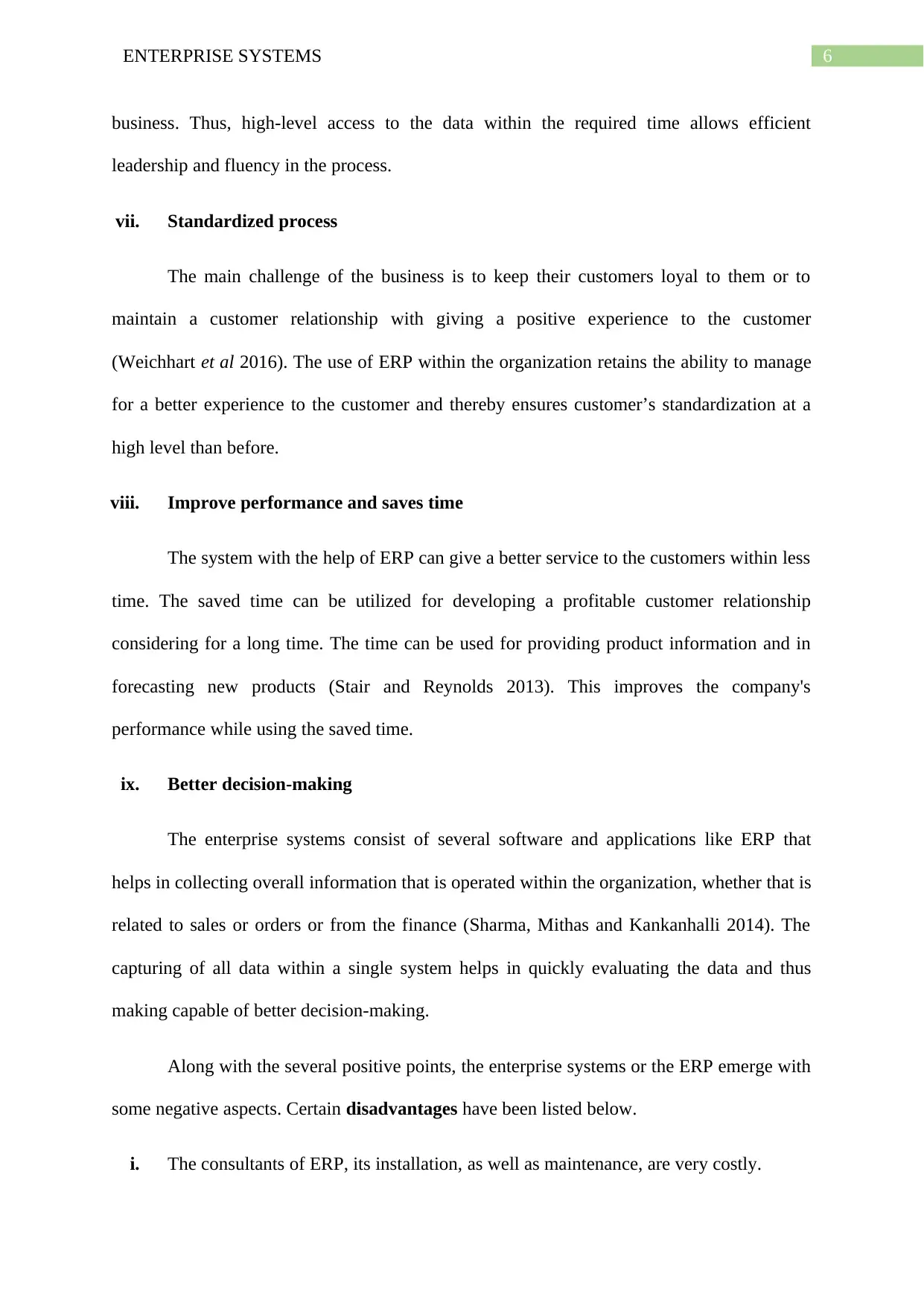
6ENTERPRISE SYSTEMS
business. Thus, high-level access to the data within the required time allows efficient
leadership and fluency in the process.
vii. Standardized process
The main challenge of the business is to keep their customers loyal to them or to
maintain a customer relationship with giving a positive experience to the customer
(Weichhart et al 2016). The use of ERP within the organization retains the ability to manage
for a better experience to the customer and thereby ensures customer’s standardization at a
high level than before.
viii. Improve performance and saves time
The system with the help of ERP can give a better service to the customers within less
time. The saved time can be utilized for developing a profitable customer relationship
considering for a long time. The time can be used for providing product information and in
forecasting new products (Stair and Reynolds 2013). This improves the company's
performance while using the saved time.
ix. Better decision-making
The enterprise systems consist of several software and applications like ERP that
helps in collecting overall information that is operated within the organization, whether that is
related to sales or orders or from the finance (Sharma, Mithas and Kankanhalli 2014). The
capturing of all data within a single system helps in quickly evaluating the data and thus
making capable of better decision-making.
Along with the several positive points, the enterprise systems or the ERP emerge with
some negative aspects. Certain disadvantages have been listed below.
i. The consultants of ERP, its installation, as well as maintenance, are very costly.
business. Thus, high-level access to the data within the required time allows efficient
leadership and fluency in the process.
vii. Standardized process
The main challenge of the business is to keep their customers loyal to them or to
maintain a customer relationship with giving a positive experience to the customer
(Weichhart et al 2016). The use of ERP within the organization retains the ability to manage
for a better experience to the customer and thereby ensures customer’s standardization at a
high level than before.
viii. Improve performance and saves time
The system with the help of ERP can give a better service to the customers within less
time. The saved time can be utilized for developing a profitable customer relationship
considering for a long time. The time can be used for providing product information and in
forecasting new products (Stair and Reynolds 2013). This improves the company's
performance while using the saved time.
ix. Better decision-making
The enterprise systems consist of several software and applications like ERP that
helps in collecting overall information that is operated within the organization, whether that is
related to sales or orders or from the finance (Sharma, Mithas and Kankanhalli 2014). The
capturing of all data within a single system helps in quickly evaluating the data and thus
making capable of better decision-making.
Along with the several positive points, the enterprise systems or the ERP emerge with
some negative aspects. Certain disadvantages have been listed below.
i. The consultants of ERP, its installation, as well as maintenance, are very costly.
Paraphrase This Document
Need a fresh take? Get an instant paraphrase of this document with our AI Paraphraser
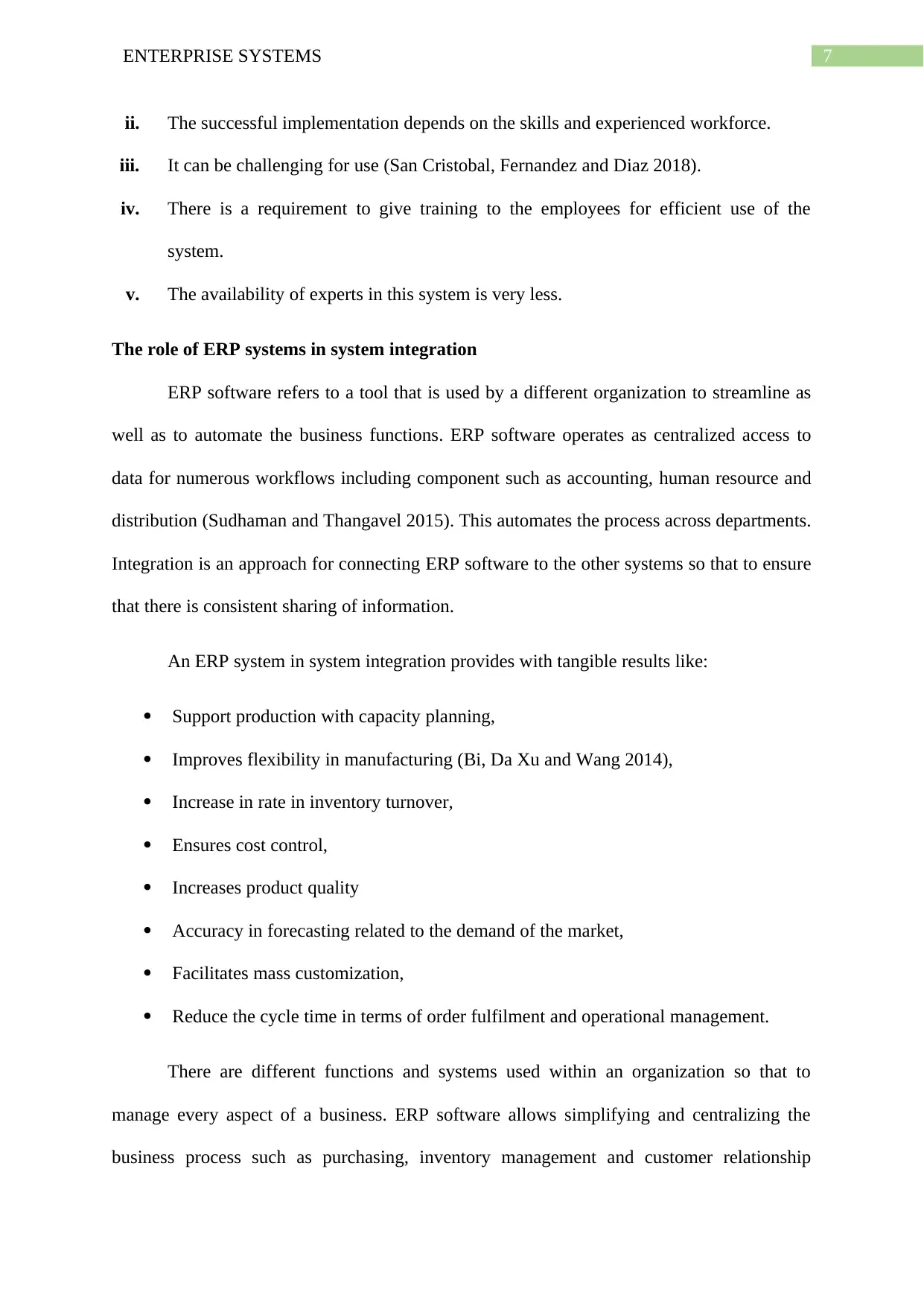
7ENTERPRISE SYSTEMS
ii. The successful implementation depends on the skills and experienced workforce.
iii. It can be challenging for use (San Cristobal, Fernandez and Diaz 2018).
iv. There is a requirement to give training to the employees for efficient use of the
system.
v. The availability of experts in this system is very less.
The role of ERP systems in system integration
ERP software refers to a tool that is used by a different organization to streamline as
well as to automate the business functions. ERP software operates as centralized access to
data for numerous workflows including component such as accounting, human resource and
distribution (Sudhaman and Thangavel 2015). This automates the process across departments.
Integration is an approach for connecting ERP software to the other systems so that to ensure
that there is consistent sharing of information.
An ERP system in system integration provides with tangible results like:
Support production with capacity planning,
Improves flexibility in manufacturing (Bi, Da Xu and Wang 2014),
Increase in rate in inventory turnover,
Ensures cost control,
Increases product quality
Accuracy in forecasting related to the demand of the market,
Facilitates mass customization,
Reduce the cycle time in terms of order fulfilment and operational management.
There are different functions and systems used within an organization so that to
manage every aspect of a business. ERP software allows simplifying and centralizing the
business process such as purchasing, inventory management and customer relationship
ii. The successful implementation depends on the skills and experienced workforce.
iii. It can be challenging for use (San Cristobal, Fernandez and Diaz 2018).
iv. There is a requirement to give training to the employees for efficient use of the
system.
v. The availability of experts in this system is very less.
The role of ERP systems in system integration
ERP software refers to a tool that is used by a different organization to streamline as
well as to automate the business functions. ERP software operates as centralized access to
data for numerous workflows including component such as accounting, human resource and
distribution (Sudhaman and Thangavel 2015). This automates the process across departments.
Integration is an approach for connecting ERP software to the other systems so that to ensure
that there is consistent sharing of information.
An ERP system in system integration provides with tangible results like:
Support production with capacity planning,
Improves flexibility in manufacturing (Bi, Da Xu and Wang 2014),
Increase in rate in inventory turnover,
Ensures cost control,
Increases product quality
Accuracy in forecasting related to the demand of the market,
Facilitates mass customization,
Reduce the cycle time in terms of order fulfilment and operational management.
There are different functions and systems used within an organization so that to
manage every aspect of a business. ERP software allows simplifying and centralizing the
business process such as purchasing, inventory management and customer relationship
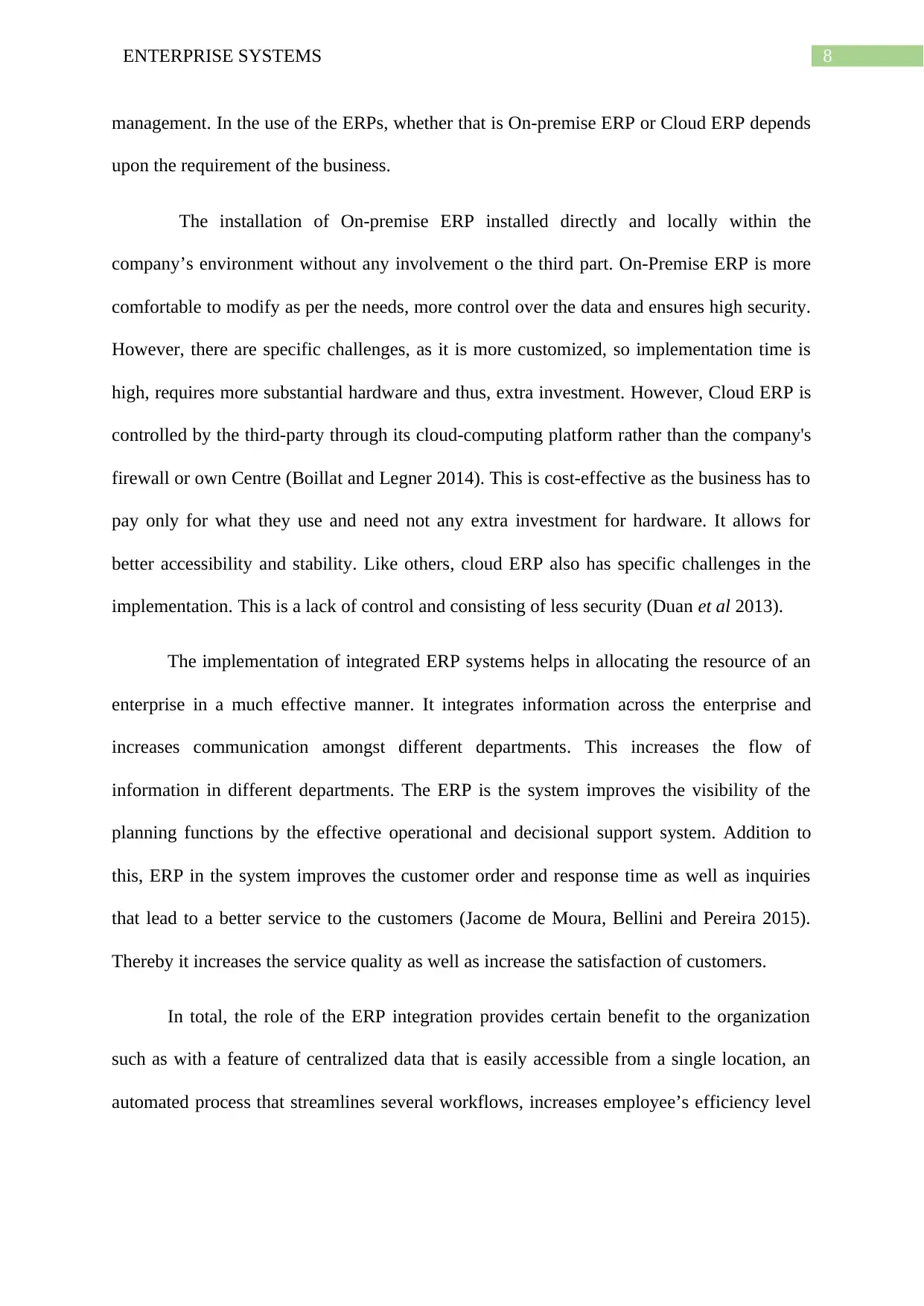
8ENTERPRISE SYSTEMS
management. In the use of the ERPs, whether that is On-premise ERP or Cloud ERP depends
upon the requirement of the business.
The installation of On-premise ERP installed directly and locally within the
company’s environment without any involvement o the third part. On-Premise ERP is more
comfortable to modify as per the needs, more control over the data and ensures high security.
However, there are specific challenges, as it is more customized, so implementation time is
high, requires more substantial hardware and thus, extra investment. However, Cloud ERP is
controlled by the third-party through its cloud-computing platform rather than the company's
firewall or own Centre (Boillat and Legner 2014). This is cost-effective as the business has to
pay only for what they use and need not any extra investment for hardware. It allows for
better accessibility and stability. Like others, cloud ERP also has specific challenges in the
implementation. This is a lack of control and consisting of less security (Duan et al 2013).
The implementation of integrated ERP systems helps in allocating the resource of an
enterprise in a much effective manner. It integrates information across the enterprise and
increases communication amongst different departments. This increases the flow of
information in different departments. The ERP is the system improves the visibility of the
planning functions by the effective operational and decisional support system. Addition to
this, ERP in the system improves the customer order and response time as well as inquiries
that lead to a better service to the customers (Jacome de Moura, Bellini and Pereira 2015).
Thereby it increases the service quality as well as increase the satisfaction of customers.
In total, the role of the ERP integration provides certain benefit to the organization
such as with a feature of centralized data that is easily accessible from a single location, an
automated process that streamlines several workflows, increases employee’s efficiency level
management. In the use of the ERPs, whether that is On-premise ERP or Cloud ERP depends
upon the requirement of the business.
The installation of On-premise ERP installed directly and locally within the
company’s environment without any involvement o the third part. On-Premise ERP is more
comfortable to modify as per the needs, more control over the data and ensures high security.
However, there are specific challenges, as it is more customized, so implementation time is
high, requires more substantial hardware and thus, extra investment. However, Cloud ERP is
controlled by the third-party through its cloud-computing platform rather than the company's
firewall or own Centre (Boillat and Legner 2014). This is cost-effective as the business has to
pay only for what they use and need not any extra investment for hardware. It allows for
better accessibility and stability. Like others, cloud ERP also has specific challenges in the
implementation. This is a lack of control and consisting of less security (Duan et al 2013).
The implementation of integrated ERP systems helps in allocating the resource of an
enterprise in a much effective manner. It integrates information across the enterprise and
increases communication amongst different departments. This increases the flow of
information in different departments. The ERP is the system improves the visibility of the
planning functions by the effective operational and decisional support system. Addition to
this, ERP in the system improves the customer order and response time as well as inquiries
that lead to a better service to the customers (Jacome de Moura, Bellini and Pereira 2015).
Thereby it increases the service quality as well as increase the satisfaction of customers.
In total, the role of the ERP integration provides certain benefit to the organization
such as with a feature of centralized data that is easily accessible from a single location, an
automated process that streamlines several workflows, increases employee’s efficiency level
⊘ This is a preview!⊘
Do you want full access?
Subscribe today to unlock all pages.

Trusted by 1+ million students worldwide
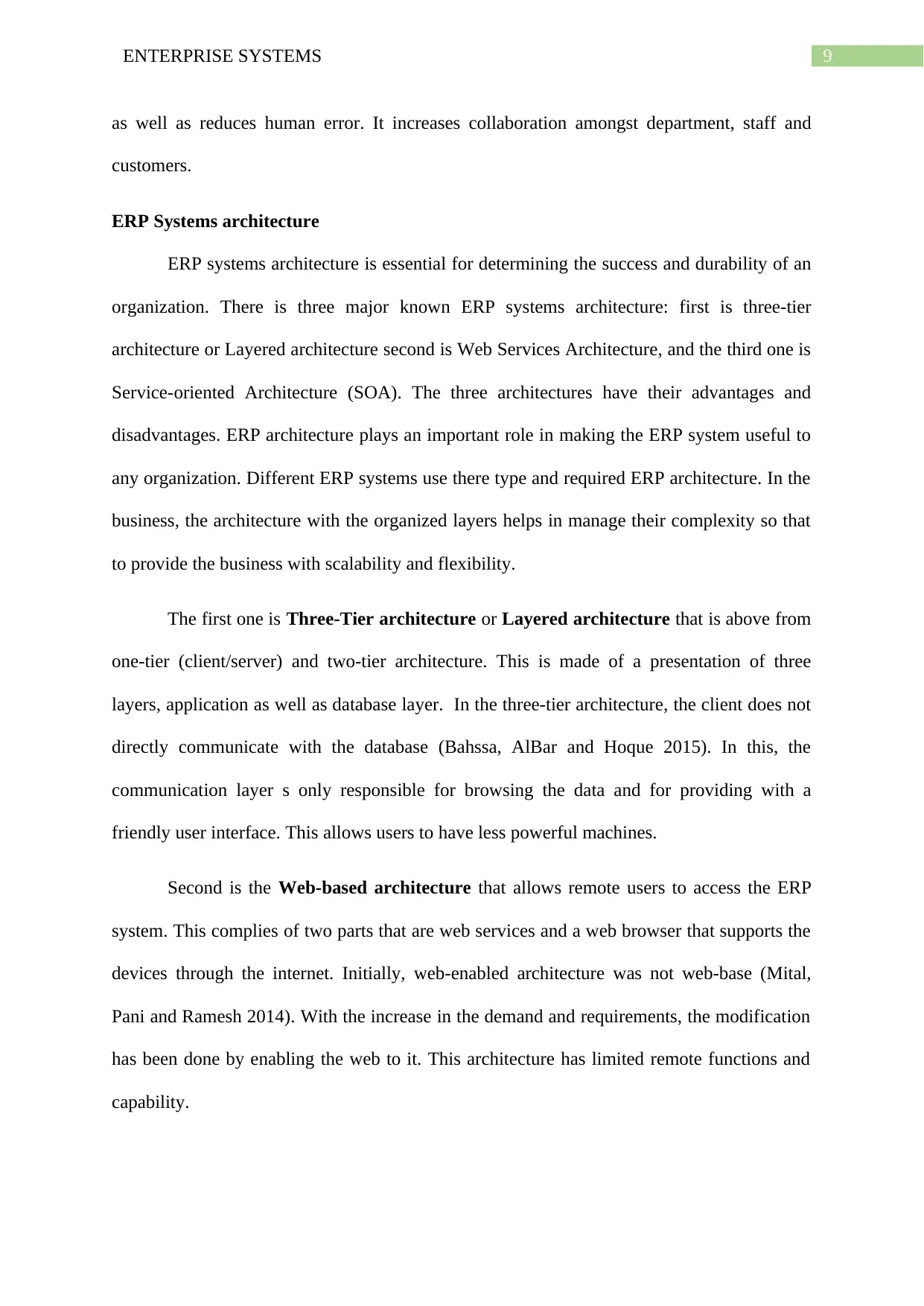
9ENTERPRISE SYSTEMS
as well as reduces human error. It increases collaboration amongst department, staff and
customers.
ERP Systems architecture
ERP systems architecture is essential for determining the success and durability of an
organization. There is three major known ERP systems architecture: first is three-tier
architecture or Layered architecture second is Web Services Architecture, and the third one is
Service-oriented Architecture (SOA). The three architectures have their advantages and
disadvantages. ERP architecture plays an important role in making the ERP system useful to
any organization. Different ERP systems use there type and required ERP architecture. In the
business, the architecture with the organized layers helps in manage their complexity so that
to provide the business with scalability and flexibility.
The first one is Three-Tier architecture or Layered architecture that is above from
one-tier (client/server) and two-tier architecture. This is made of a presentation of three
layers, application as well as database layer. In the three-tier architecture, the client does not
directly communicate with the database (Bahssa, AlBar and Hoque 2015). In this, the
communication layer s only responsible for browsing the data and for providing with a
friendly user interface. This allows users to have less powerful machines.
Second is the Web-based architecture that allows remote users to access the ERP
system. This complies of two parts that are web services and a web browser that supports the
devices through the internet. Initially, web-enabled architecture was not web-base (Mital,
Pani and Ramesh 2014). With the increase in the demand and requirements, the modification
has been done by enabling the web to it. This architecture has limited remote functions and
capability.
as well as reduces human error. It increases collaboration amongst department, staff and
customers.
ERP Systems architecture
ERP systems architecture is essential for determining the success and durability of an
organization. There is three major known ERP systems architecture: first is three-tier
architecture or Layered architecture second is Web Services Architecture, and the third one is
Service-oriented Architecture (SOA). The three architectures have their advantages and
disadvantages. ERP architecture plays an important role in making the ERP system useful to
any organization. Different ERP systems use there type and required ERP architecture. In the
business, the architecture with the organized layers helps in manage their complexity so that
to provide the business with scalability and flexibility.
The first one is Three-Tier architecture or Layered architecture that is above from
one-tier (client/server) and two-tier architecture. This is made of a presentation of three
layers, application as well as database layer. In the three-tier architecture, the client does not
directly communicate with the database (Bahssa, AlBar and Hoque 2015). In this, the
communication layer s only responsible for browsing the data and for providing with a
friendly user interface. This allows users to have less powerful machines.
Second is the Web-based architecture that allows remote users to access the ERP
system. This complies of two parts that are web services and a web browser that supports the
devices through the internet. Initially, web-enabled architecture was not web-base (Mital,
Pani and Ramesh 2014). With the increase in the demand and requirements, the modification
has been done by enabling the web to it. This architecture has limited remote functions and
capability.
Paraphrase This Document
Need a fresh take? Get an instant paraphrase of this document with our AI Paraphraser
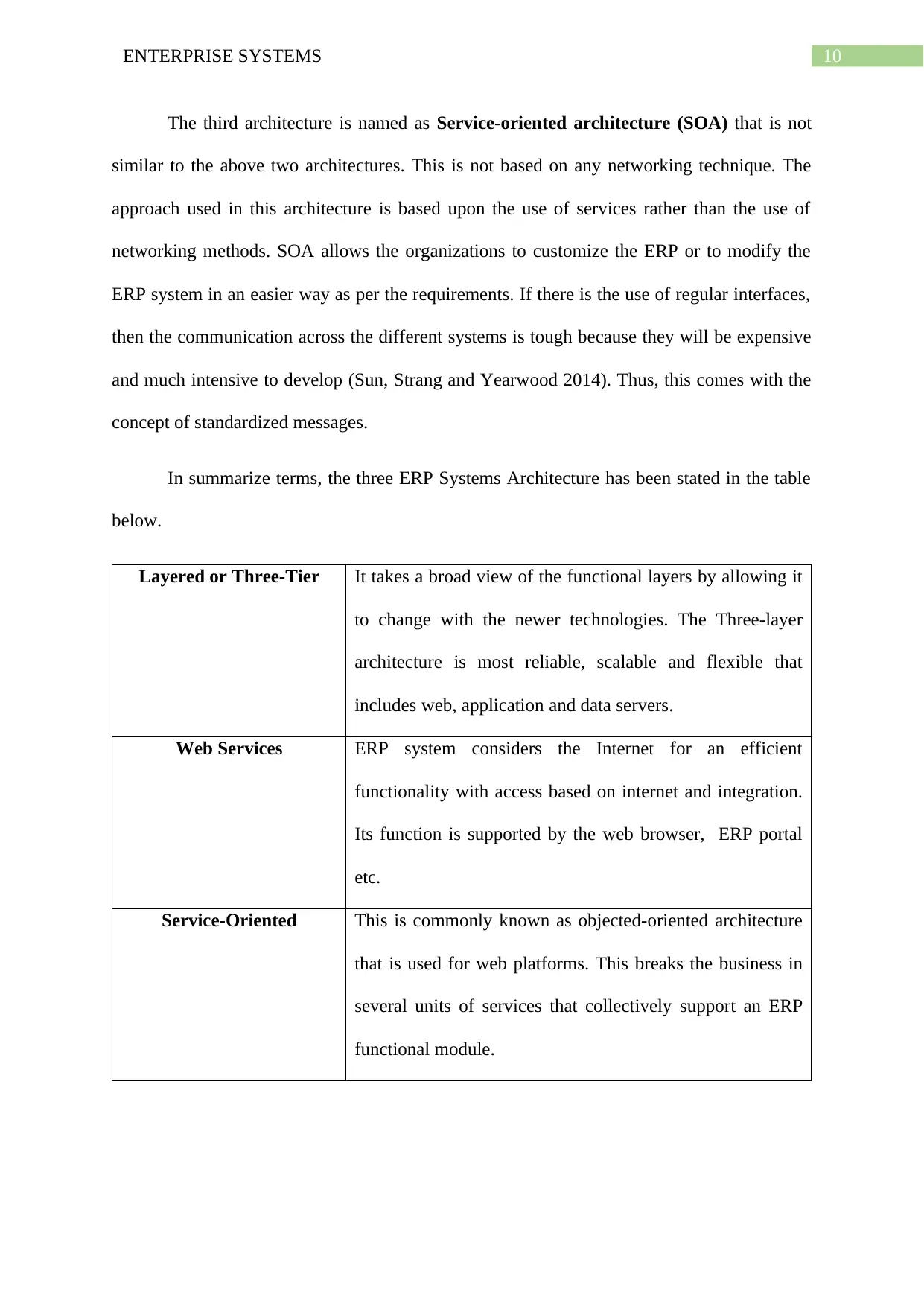
10ENTERPRISE SYSTEMS
The third architecture is named as Service-oriented architecture (SOA) that is not
similar to the above two architectures. This is not based on any networking technique. The
approach used in this architecture is based upon the use of services rather than the use of
networking methods. SOA allows the organizations to customize the ERP or to modify the
ERP system in an easier way as per the requirements. If there is the use of regular interfaces,
then the communication across the different systems is tough because they will be expensive
and much intensive to develop (Sun, Strang and Yearwood 2014). Thus, this comes with the
concept of standardized messages.
In summarize terms, the three ERP Systems Architecture has been stated in the table
below.
Layered or Three-Tier It takes a broad view of the functional layers by allowing it
to change with the newer technologies. The Three-layer
architecture is most reliable, scalable and flexible that
includes web, application and data servers.
Web Services ERP system considers the Internet for an efficient
functionality with access based on internet and integration.
Its function is supported by the web browser, ERP portal
etc.
Service-Oriented This is commonly known as objected-oriented architecture
that is used for web platforms. This breaks the business in
several units of services that collectively support an ERP
functional module.
The third architecture is named as Service-oriented architecture (SOA) that is not
similar to the above two architectures. This is not based on any networking technique. The
approach used in this architecture is based upon the use of services rather than the use of
networking methods. SOA allows the organizations to customize the ERP or to modify the
ERP system in an easier way as per the requirements. If there is the use of regular interfaces,
then the communication across the different systems is tough because they will be expensive
and much intensive to develop (Sun, Strang and Yearwood 2014). Thus, this comes with the
concept of standardized messages.
In summarize terms, the three ERP Systems Architecture has been stated in the table
below.
Layered or Three-Tier It takes a broad view of the functional layers by allowing it
to change with the newer technologies. The Three-layer
architecture is most reliable, scalable and flexible that
includes web, application and data servers.
Web Services ERP system considers the Internet for an efficient
functionality with access based on internet and integration.
Its function is supported by the web browser, ERP portal
etc.
Service-Oriented This is commonly known as objected-oriented architecture
that is used for web platforms. This breaks the business in
several units of services that collectively support an ERP
functional module.
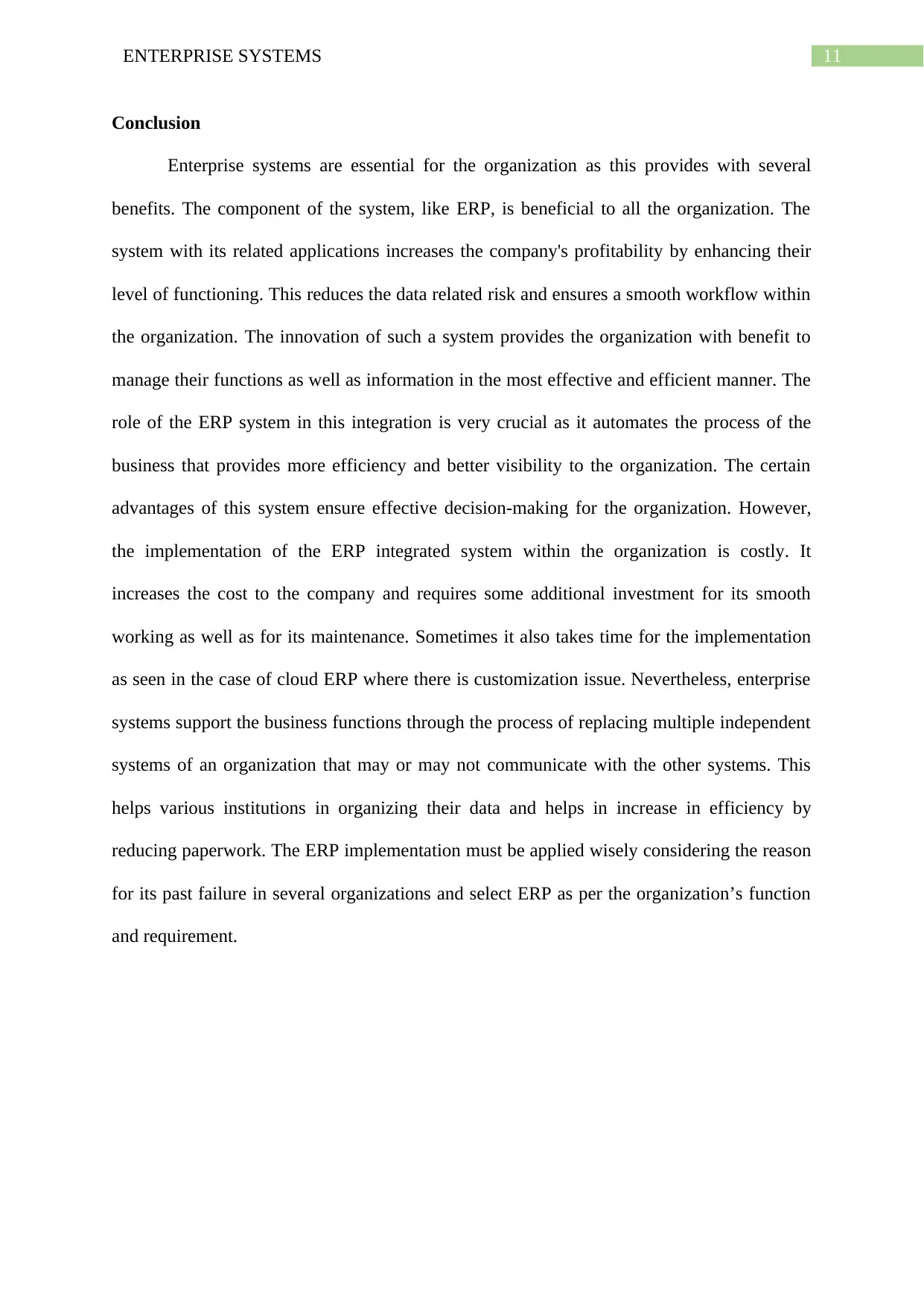
11ENTERPRISE SYSTEMS
Conclusion
Enterprise systems are essential for the organization as this provides with several
benefits. The component of the system, like ERP, is beneficial to all the organization. The
system with its related applications increases the company's profitability by enhancing their
level of functioning. This reduces the data related risk and ensures a smooth workflow within
the organization. The innovation of such a system provides the organization with benefit to
manage their functions as well as information in the most effective and efficient manner. The
role of the ERP system in this integration is very crucial as it automates the process of the
business that provides more efficiency and better visibility to the organization. The certain
advantages of this system ensure effective decision-making for the organization. However,
the implementation of the ERP integrated system within the organization is costly. It
increases the cost to the company and requires some additional investment for its smooth
working as well as for its maintenance. Sometimes it also takes time for the implementation
as seen in the case of cloud ERP where there is customization issue. Nevertheless, enterprise
systems support the business functions through the process of replacing multiple independent
systems of an organization that may or may not communicate with the other systems. This
helps various institutions in organizing their data and helps in increase in efficiency by
reducing paperwork. The ERP implementation must be applied wisely considering the reason
for its past failure in several organizations and select ERP as per the organization’s function
and requirement.
Conclusion
Enterprise systems are essential for the organization as this provides with several
benefits. The component of the system, like ERP, is beneficial to all the organization. The
system with its related applications increases the company's profitability by enhancing their
level of functioning. This reduces the data related risk and ensures a smooth workflow within
the organization. The innovation of such a system provides the organization with benefit to
manage their functions as well as information in the most effective and efficient manner. The
role of the ERP system in this integration is very crucial as it automates the process of the
business that provides more efficiency and better visibility to the organization. The certain
advantages of this system ensure effective decision-making for the organization. However,
the implementation of the ERP integrated system within the organization is costly. It
increases the cost to the company and requires some additional investment for its smooth
working as well as for its maintenance. Sometimes it also takes time for the implementation
as seen in the case of cloud ERP where there is customization issue. Nevertheless, enterprise
systems support the business functions through the process of replacing multiple independent
systems of an organization that may or may not communicate with the other systems. This
helps various institutions in organizing their data and helps in increase in efficiency by
reducing paperwork. The ERP implementation must be applied wisely considering the reason
for its past failure in several organizations and select ERP as per the organization’s function
and requirement.
⊘ This is a preview!⊘
Do you want full access?
Subscribe today to unlock all pages.

Trusted by 1+ million students worldwide
1 out of 17
Related Documents
Your All-in-One AI-Powered Toolkit for Academic Success.
+13062052269
info@desklib.com
Available 24*7 on WhatsApp / Email
![[object Object]](/_next/static/media/star-bottom.7253800d.svg)
Unlock your academic potential
Copyright © 2020–2025 A2Z Services. All Rights Reserved. Developed and managed by ZUCOL.





